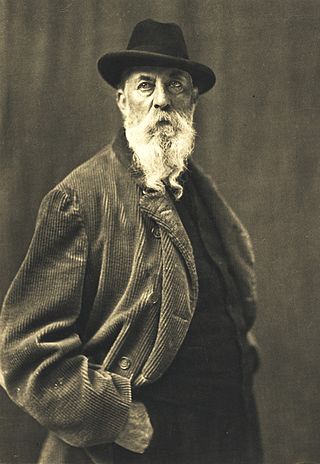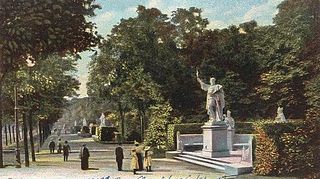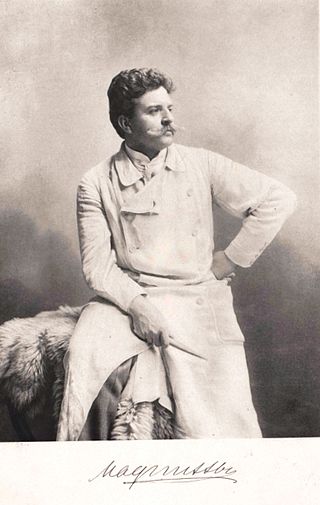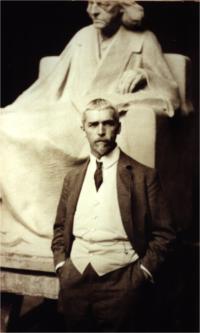
August Friedrich Johann Kraus (9 July 1868, Ruhrort - 8 February 1934, Berlin) was a German sculptor.

August Friedrich Johann Kraus (9 July 1868, Ruhrort - 8 February 1934, Berlin) was a German sculptor.

He was the son of a coachman. In 1877, the family moved to Baden-Baden where he became an apprentice to a headstone sculptor. His family moved again in 1883, this time to Strasbourg, and he continued his studies at the municipal Arts and Crafts School. From 1887 to 1891, he was enrolled at the Prussian Academy of Art in Berlin, where he studied with Ernst Herter. For the next seven years, he was a Master Student of Reinhold Begas and continued to work under his influence for some time after. [1]
In 1900. his work on the Siegesallee (Victory Avenue) project won him the Academy's "Staatspreis", which included a stipendium for five years of study in Rome. This enabled him to break away from his artistic and financial dependence on Begas. Once there, his style took a turn towards Neoclassicism. [1] Upon his return, he became a member of the Berlin Secession and served as its vice-president from 1911 to 1913. [2] He was Director of the Rauch-Museum from 1914 to 1920. The Sculptors' Association of Berlin elected him its first President. His work was part of the sculpture event in the art competition at the 1928 Summer Olympics. [3]
After the Nazi Machtergreifung in 1933, he signed a Declaration of Loyalty to Hitler and became a member of the Presidential Council of the Reichskulturkammer. [4] That same year, he was appointed chairman of the Department of Fine Arts in a newly "cleansed" Academy and served as Provisional President until his death. [4] [5] It has been reported that he died at the exact moment his statue of Henry the Child in the Siegesallee was being damaged by a storm, but this is probably apocryphal. He is buried in the Friedhof Heerstraße, but also has an "honorary grave" in Berlin.


Johann Heinrich von Dannecker was a German sculptor.

Reinhold Begas was a German sculptor.

The Siegesallee was a broad boulevard in Berlin, Germany. In 1895, Kaiser Wilhelm II ordered and financed the expansion of an existing avenue, to be adorned with a variety of marble statues. Work was completed in 1901.

Harro Magnussen was a German sculptor.

The Berlin Secession was an art movement established in Germany on May 2, 1898. Formed in reaction to the Association of Berlin Artists, and the restrictions on contemporary art imposed by Kaiser Wilhelm II, 65 artists "seceded," demonstrating against the standards of academic or government-endorsed art. The movement is classified as a form of German Modernism, and came on the heels of several other secessions in Germany, including Jugendstil and the Munich Secession.

Karl Begas was a German sculptor. To distinguish him from his father, he is often referred to as "the younger".
Henry II of Brandenburg-Stendal, nicknamed Henry the Younger or Henry the Child was the last margrave of Brandenburg from the House of Ascania.

Adolf Brütt was a German sculptor. He was the founder of the Weimarer Bildhauerschule and its accompanying bronze foundry.

Reinhold Carl Thusmann Felderhoff was a German sculptor.

Karl Ludwig Manzel was a German sculptor, painter and graphic artist.

Joseph Johann Ludwig Uphues was a German sculptor.

Eugen Boermel, also spelled Börmel was a German sculptor, writer and inventor.

Johannes Boese, also spelled Böse, was a German sculptor and art professor.

Ludwig Cauer was a German sculptor.

Cuno von Uechtritz-Steinkirch was a German sculptor.

Martin Wolff was a German sculptor.

The Siegesdenkmal in Freiburg im Breisgau is a monument to the German victory in the Franco-Prussian War in 1871. It was erected at the northern edge of the historic center of Freiburg im Breisgau next to the former Karlskaserne (barracks). After World War II it was moved 100m to the west. Today it is located on Europaplatz.

Gustav Halmhuber was a German architect and university teacher. His style reflected the flamboyance and brittle optimism of the early twentieth century. Perhaps his best known surviving work – also one of his earliest commissions – is the WaterTower (1886–1889) in Mannheim.
Lukas Ferdinand Schlöth was a Swiss sculptor in the late Classical style.

Nikolaus Friedrich was a German sculptor.